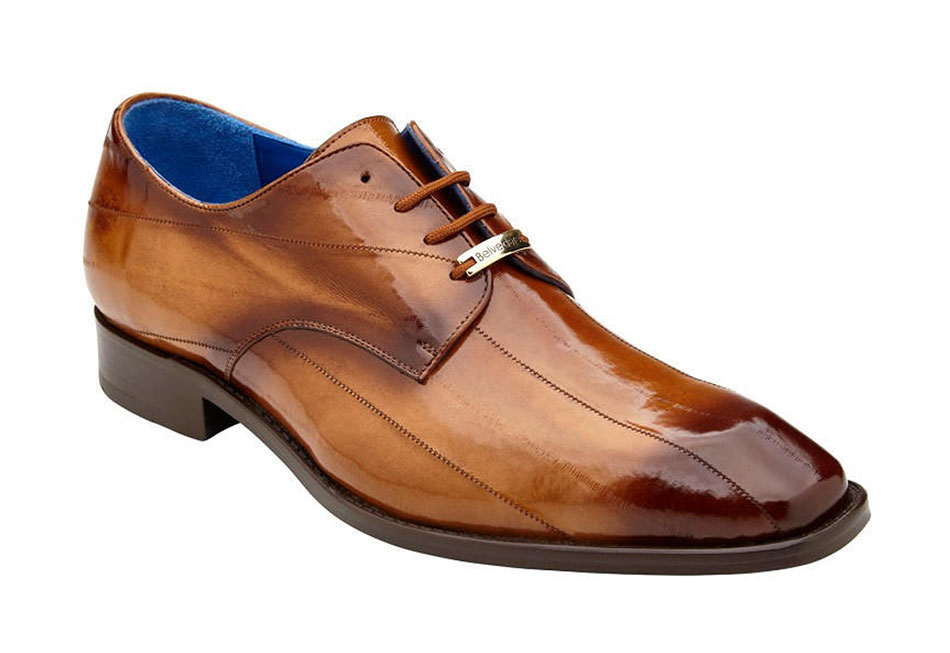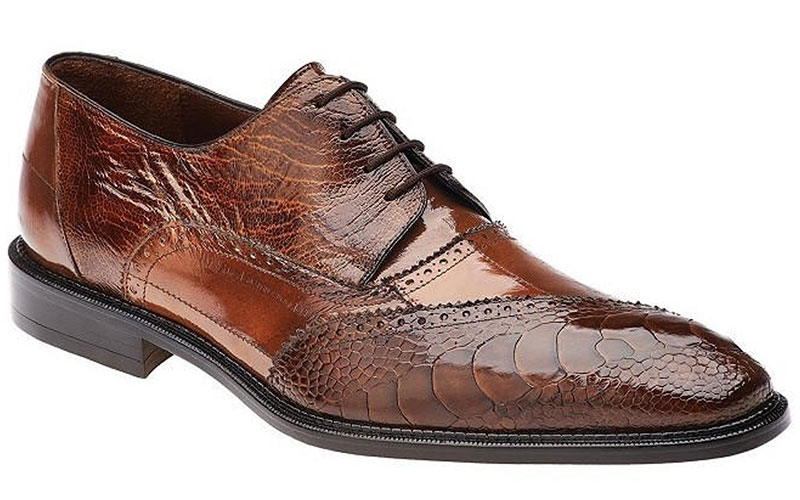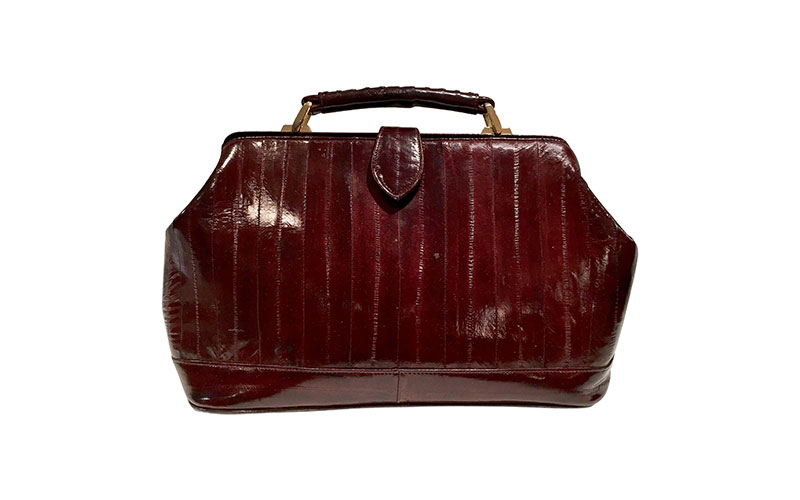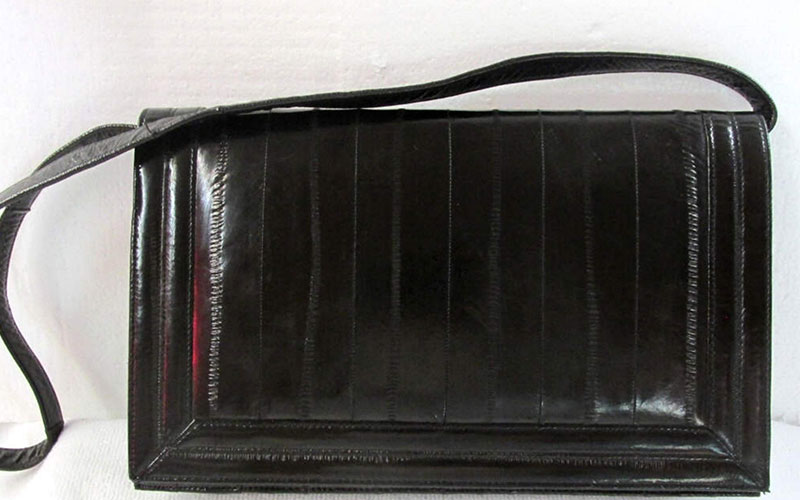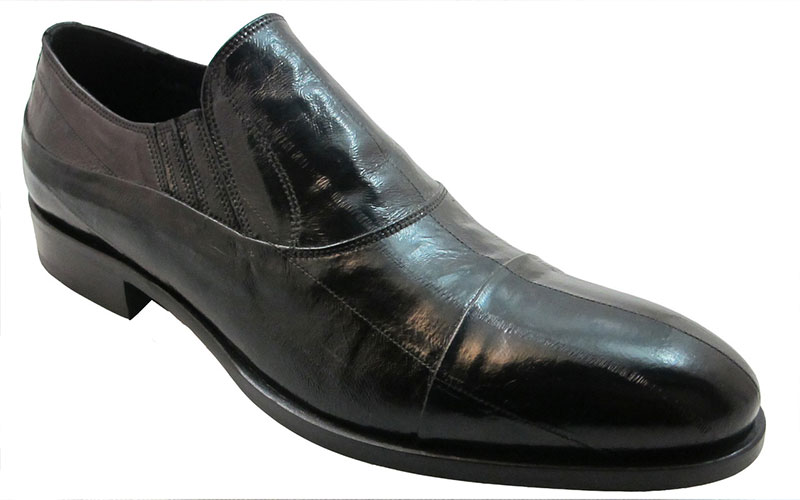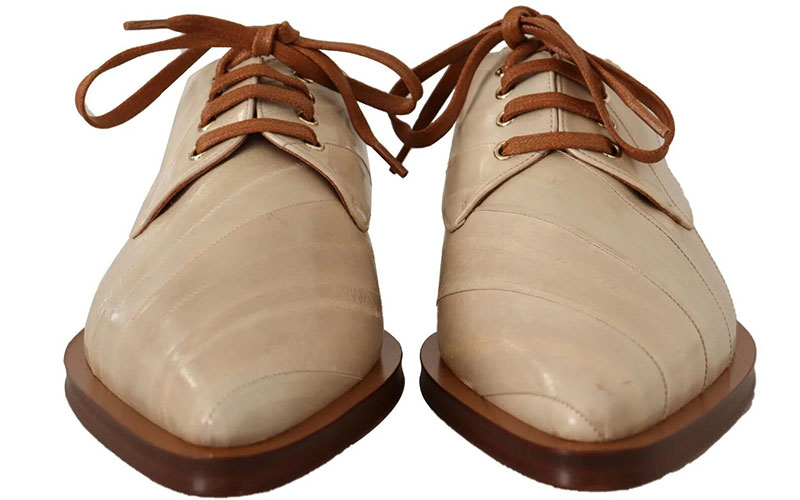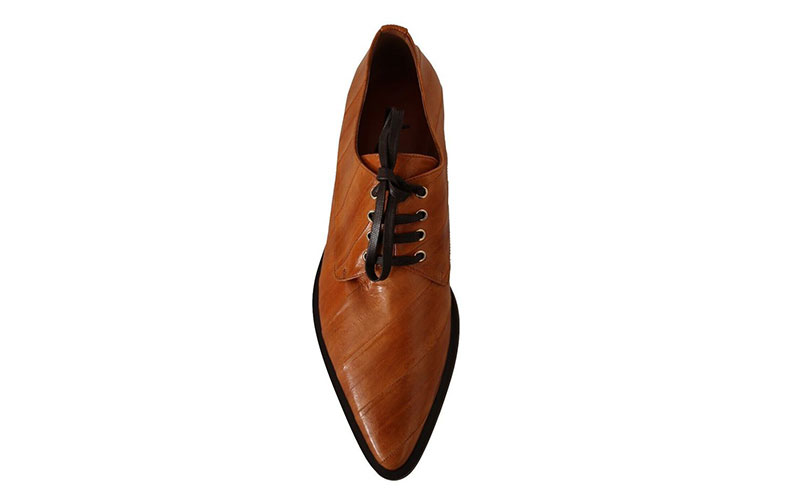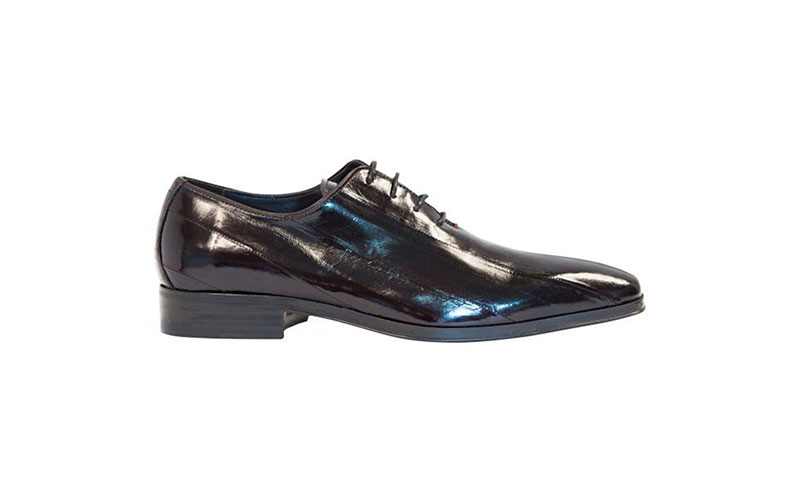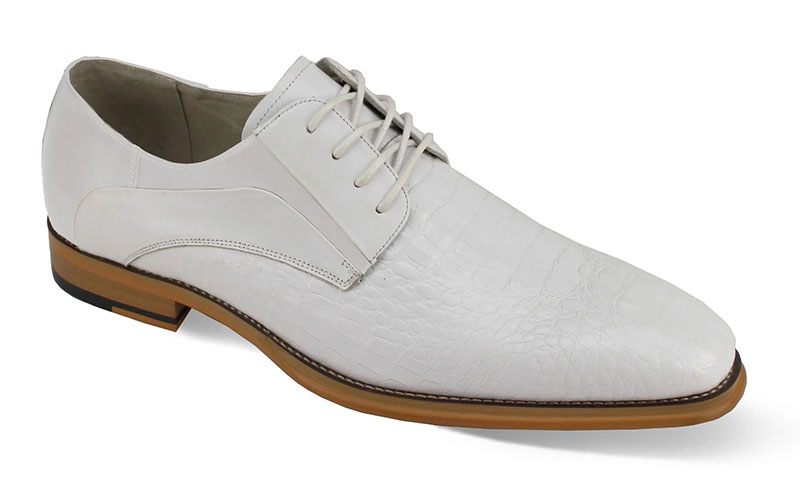Eel skin leather is a popular choice for those looking to add an exotic touch to their shoes, handbags, wallets and other accessories. But what about eel skin leather repair? What about routine maintenance? Does exotic leather mean complicated care?
Let Cobbleron’s complete guide to eel skin leather care answer these questions and more!
On This Article:
- Is eel skin better than leather?
- How durable is eel skin?
- Does eel leather stretch?
- Is eel skin good for boots?
- How do you care for eel leather?
- How do you condition eel leather?
- How does a cobbler repair eel skin?
- Trust Cobbleron with your eel skin leather repair and care
Is eel skin better than leather?
“Better” is a relative term. Eel skin is certainly different from traditional cowhide leather. But, ultimately it comes down to a matter of taste. Many leather aficionados enjoy eel skin products as a rare and exotic addition to their wardrobe and accessories. Because it is more exotic, eel skin is usually more expensive than standard leather. However, this doesn’t necessarily make it better. In the end, whatever type of leather you love the most is what’s best for you.
How durable is eel skin?
Eel skin leather is notably stronger than cowhide leather. Sources are conflicting, but they report that eel leather is anywhere from 3 to 150 times as strong as traditional leather of the same thickness. However, eel skin is naturally much thinner than cowhide. For this reason, almost every eel skin product is not 100% eel leather. Rather, they are comprised of eel skin laminates that are adhered to a cowhide or synthetic base. This allows you to enjoy the aesthetics of eel leather at a thickness of traditional leather.
Eel skin leather purses feature a remarkably upscale elegance denoted by their svelte and frequently vibrant appearance. – Myaurochs.com
Does eel leather stretch?
Eel leather actually comes from the hagfish, whose skin fits sort of like a loose sock around the rest of the body. When formed into a leather product, this stretchy quality of eel skin is retained to a certain extent. Your eel skin shoes aren’t going to stretch like spandex, especially because they likely have a cowhide foundation. However, the surface is a little more flexible. This will be most noticeable if you get them wet, when it is extra important not to stretch the leather out to avoid misshaping it.
Is eel skin good for boots?
Yes, eel skin is an ideal choice for shoes and boots. However, because of its stretchy nature, eel skin is best reserved for fancy dress boots rather than work boots. They aren’t meant for a hard day of labor on the farm.
How do you care for eel leather?
Caring for your eel leather products is equal parts routine maintenance and damage control. Let’s look at what you need to do to ensure that your eel skin lasts as long as possible.
Keep it dry
The good news is that, much like traditional leather, eel leather is very resistant to water. However, this doesn’t mean you have permission to wear your boots to the dunking booth.
A good guideline to follow is that you should never purposely expose eel leather to excessive water. When it’s raining more than a light drizzle, keep the eel skin shoes at home. And, if any of your products do get sopping wet, dry them out the best you can as quickly as you can. Use a dry, gentle cloth and avoid rubbing the leather or agitating it vigorously. This can cause the leather to stretch out of shape. Light splashes of water aren’t usually an issue. The leather might look stained, but it will go away once the water dries. The real danger comes from extended exposure to large amounts of moisture. This can weaken and discolour the leather.
Eel leather is fairly water resistant. Although exposure to water in a spill will likely darken your leather temporarily, the color will return as the skin dries. Sodas or juices, on the other hand, will need slightly more attention. – Leathermilk.com
Store your eel leather products properly
Whether it’s a purse, a pair of shoes or a wallet, you want to store your eel leather in a manner that prevents dust and damage. Here are some ways to do this:
- Place items in a sealed, breathable dust bag whenever you won’t be using them for more than a week. This will prevent the accumulation of dust, which will require extra cleaning and is thus a preventable source of wear and tear.
- Stuff shoes and hand bags with newspaper or similar gentle material to help them keep their shape when in storage.
- Avoid placing other items on top of your eel skin products to prevent creases or other malformations.
Avoid too much direct heat or sun
Prolonged exposure to high heat or direct sunlight can discolour and weaken your eel leather. It’s okay to wear it out for a few hours on a hot or sunny day, especially if you’ll be in and out of the shade. However, don’t bring your eel purse to the beach. Don’t leave your boots lying in a sunny window all day. And don’t try to dry out wet eel leather by putting it next to the fireplace.
Keep your eel skin styles away from sunlight and heat, as the delicate surface might lose colour or be otherwise damaged. – Becksondergaard.com
Clean it when stained (or at least 3 times a year)
You should plan to routinely clean your eel skin products about three times a year, or whenever they get particularly dirty or stained. Here is a general method to follow for regular cleaning:
- Dust with a gentle cloth. Use microfibre or something similarly non-abrasive. The goal here is simply to remove as much surface dust and dirt as possible.
- Use a brush for crevices. Next, you want to gently scrub the hard to reach places with a brush. While a toothbrush does the trick in a pinch, a horsehair brush is the preferred tool of the trade. The goal at this point is to loosen any dirt or debris that has become caked in.
- Wash with mild soap and water. You can use specialty cleaners designed for “exotic leathers” or a very mild household soap. Apply it to a damp cloth and then gently scrub the leather all over. If the surface is particularly dirty, rinse your cloth often during this process to avoid simply spreading the mess around.
- Towel and air dry. Once the leather is thoroughly cleaned, use a fresh cloth to pat it dry. Then, set it somewhere safe to finish air drying. Don’t try to speed the process by putting it in the sun or on top of the radiator. Remember, direct heat and sunlight are the enemy of eel skin leather.
Here are our tips for more specific or serious types of stains. Remember that if you are ever worried that you aren’t up for the complexities of eel skin leather care, you can always call in professional assistance.
- Act fast! When it comes to stains from anything that could seep into the leather (like wine, ink or grease), the faster you tend to the stain, the more likely you will be able to get it out.
- Try and try again. Stain removal doesn’t always work the first time. If that oil stain is still there after you let your eel skin boots dry, give it another go. Even if it takes several attempts, the stain will likely get fainter and fainter each time. Just don’t get overzealous and scrub your leather too hard. Always be gentle.
- Removing juice, soda and other sugary liquids isn’t usually too difficult. Follow our general cleaning steps above. If the stain is particularly large, though, you might need professional help.
- Removing oily stains can be a little tougher. If you spill grease or olive oil on your eel leather, for example, use a cloth to dab up as much as you can. Avoid rubbing initially, as this could spread the stain. Then, brush a layer of rubber cement over the stain. Once it dries, peel it off and it will take a good deal of the oil up with it. Repeat as necessary until the stain is removed.
- Removing ink stains might be impossible if you don’t act very fast. Just like with oil, try to dab as much of it off without spreading it around. Dab until it is dry, then lightly rub the stain with an eraser to see if you can remove the rest. If the eraser isn’t working, you probably want to call in a professional.
How do you condition eel leather?
Eel skin care doesn’t end with cleaning. You should also regularly condition your boots, shoes and wallets in order to restore and maintain the flexibility of the eel leather fibres. When the natural oils of leather wear out over time, conditioning helps prevent it from cracking.
Here’s the process:
- Clean the leather. Start by following our guide above to clean the eel leather.
- Apply specialty leather conditioner. Look for a conditioner that is labeled for exotic leather or reptile skin. Sometimes, you’ll even be able to find products that are specifically listed for eel skin. Just make sure you avoid wax conditioners, opting for a cream one instead. Use a clean, dry microfibre cloth to gently dab the conditioner over the entire surface of the leather.
- Let the conditioner dry for 10 – 15 minutes. You will notice that the colour will look dull during this time. Don’t worry. That’s normal. You haven’t ruined your leather.
- Buff the conditioner out. Using a different clean, dry microfibre cloth, rub the leather all over until you have removed all of the conditioner that is still on the surface. You will see the colour return to your leather, accompanied by a vibrant shine.
How does a cobbler repair eel skin?
Eel skin shoe repair is similar to other sorts of leather repairs. The primary difference that needs to be considered is that generally you are working with an eel skin veneer that has been laminated on top of a cowhide leather. This doesn’t mean much for you. But for your cobbler, it means they might need to use a mix of leathers depending on how deep the damage goes.
Here are some of the most common eel skin shoe repair services you might employ a cobbler to take care of:
- Dyeing Eel Skin. You might want your shoes dyed just because you’re in the mood for a new colour. However, dyeing to a shade darker may also be necessary if you have a stubborn stain that won’t come out.
- Filling or Patching Eel Skin. If you have cracks, tears or holes in your shoes, a cobbler will decide if the best eel skin shoe repair technique is either to use a filler or to affix a new patch of leather. Whichever route we take, the cobblers at Cobbleron always aim for a fix that restores the aesthetics of the shoe and shows minimal signs of repair.
- Replacing Zips, Heels, Lining, Elastics and More. Of course, all of the non-eel parts of your shoes might need repair at some point as well. Pretty much every part of the shoe can be replaced or restored, as long as the damage isn’t too extensive.
Trust Cobbleron with your eel skin leather repair and care
If those exotic eel skin shoes of yours are wearing out and you want to get a few more years out of them, call your cobbler!
If you spilled a glass of red wine on your eel skin purse and can’t get the stain out yourself, call your cobbler!
If there is any aspect of caring for your eel skin products that you want to entrust to a professional, call your cobbler!

